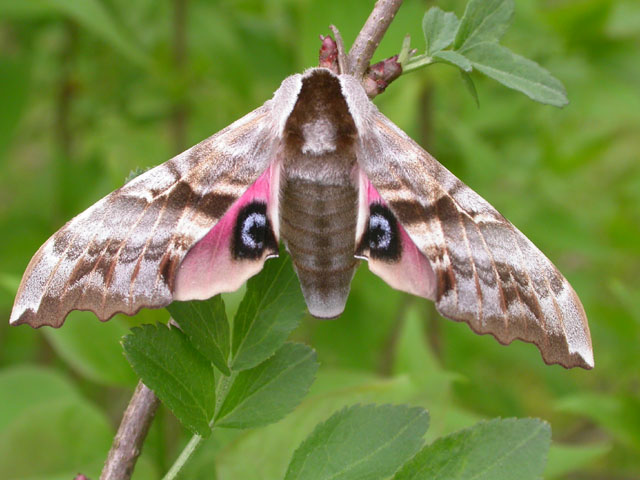Sphinginae subfamily
Sphingini tribe:
 |
Ceratomia undulosa
WO, Waved
Sphinx: Upperside of fw is pale brownish gray with wavy black
and white lines and black-outlined white cell spot. Upperside
of hw is gray with diffuse darker bands.
Some individuals are almost black; others light
yellowish brown. Note black and white collar separating thorax from
abdomen.
|
Ceratomia undulosa, Montague, July, Bill Oehlke
 |
The upperside of the forewing is gray with heavy black bands. The
upperside of the hindwing is brownish gray with no markings.
The underside is rather plain.
|
Lapara bombycoides, Montague, late June-early July, Bill Oehlke
 |
Sphinx drupiferarum
WO,
the Wild Cherry
Sphinx: Forewings, long and slender, are held
close to the body when the moth is at rest. There is a wide pale grey band extending from the body
along the costa about two-thirds of the way to the forewing apex. The terminal area is also
light in colour. The rest of the forewing is dark, slate grey.
|
Sphinx drupiferarum, Montague, mid June to early July, Bill Oehlke
 |
The lower forewings are predominantly brownish-yellow with a fairly
wide dark bar along the inner margin. At rest the wings hug the body,
giving the moth a long slender look.
|
Sphinx kalmiae, Montague, mid to late June, Bill Oehlke
 |
Sphinx poecila
WO, the Poecila
Sphinx: FW fringes checkered black and white, almost pure white (lightly checked with grey) on HW.
FW dark gray with diffuse black and gray wavy lines with series of black dashes ending at wing tip,
and white cell spot which readily distinguishes poecila from canadensis. HW brownish gray
with wide black border, black median line.
|
Sphinx poecila, Montague, mid to late June, Bill Oehlke
Smerinthini Tribe:
 |
Pachysphinx modesta
WO
the Modest Sphinx or Poplar Sphinx:
This moth has a large, heavy body,
and females can be remarkably plump. FW inner third is light grey-brown
with darker brown median area.
|
Pachysphinx modesta, Montague, mid to late June, Bill Oehlke
 |
Paonias excaecata
WO, the Blinded Sphinx: FW outer margin is quite wavy. There is a dark cell spot and a
dark oblique line mid wing from the costa almost to the inner margin. Basic ground colour is pinkish brown.
The moth gets its name from the blue-gray pupil surrounded by black, with hot pink wing scales
in the basal area of the hindwing.
|
Paonias excaecata, Montague, mid June to early July, Bill Oehlke
 |
Paonias myops
WO, the Small-eyed Sphinx:
This species is named for the small eye-spot in the hindwing. The forewing is dark brown with yellow, black, grey
and blue markings.
|
Paonias myops, Montague, mid June to early July, Bill Oehlke
 |
Smerinthus cerisyi
WO, the Cerisyi's Sphinx: This species is quite similar to Smerinthus jamaicensis, but the
grey C-shape just below the apex reaches the outer margin in S. jamaicensis, whereas in S. cerisyi
it is only a partial arc.
|
Smerinthus cerisyi, Montague, early June to early July, Bill Oehlke
 |
Smerinthus jamaicensis
WO, the Twin-spotted Sphinx:
S. jamaicensis closely resembles S. cerisyi, but jamaicensis is smaller with larger blue patches on more vibrant and
deeper purple in lower wings. Note complete (i.e. outer margin to outer margin) off-white C-shape below forewing apex.
S. cerisyi has only a partial arc.
|
Smerinthus cerisyi, Montague, mid June to late July, Bill Oehlke
Macroglossinae subfamily
Dilophonotini tribe:
 |
Hemaris thysbe
WO, the Hummingbird Clearwing
It is not difficult to see why many gardeners would mistake an
Hemaris thysbe moth for a small hummingbird as it hovers, sipping
nectar from flowers through a long feeding tube.
|
Hemaris thysbe, Montague, mid June to early July, Bill Oehlke
Macroglossini tribe:
 |
Amphion floridensis
WO, the Nessus Sphinix
The adult Nessus sphinx, which flies during the day and at dusk, has two bright yellow bands on the tufted abdomin.
At rest, dark red-brown upperwings hide the red-orange median band and yellow spot of the
hindwings; in some Amphion floridensis moths the median band may be very pale or almost absent.
|
Amphion floridensis, Montague, mid June to early July, Bill Oehlke
 |
They are common in New Jersey (my boyhood home) and common
here on Prince Edward Island.
You will often see this species listed as Darapsa pholus,
especially in older literature. It is almost cetrtainly present.
|
Darapsa choerilus, Montague, mid June to late July, Bill Oehlke
 |
Hyles gallii
WO, the Bedstraw Hawk Moth
or Gallium Sphinx
This forewing is dark brown with a slightly irregular cream-coloured transverse line. The outer margin is grey.
There is a bright pink band on the hindwing. Caterpillars feed on fireweed.
|
Hyles gallii, Montague, early July, Bill Oehlke
|
|

